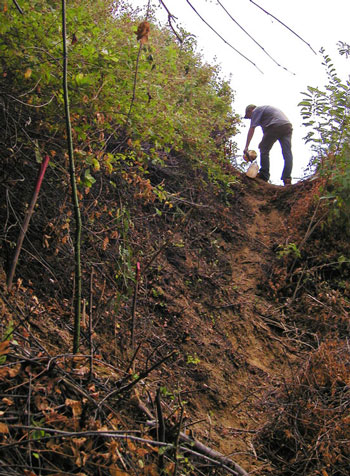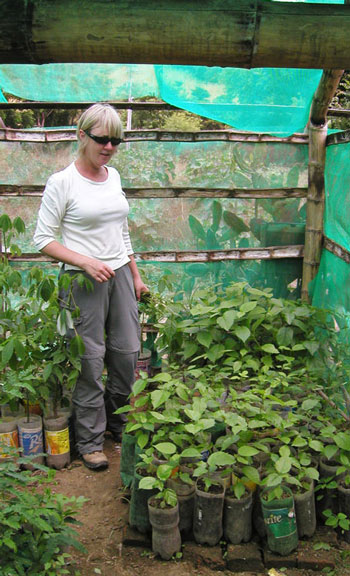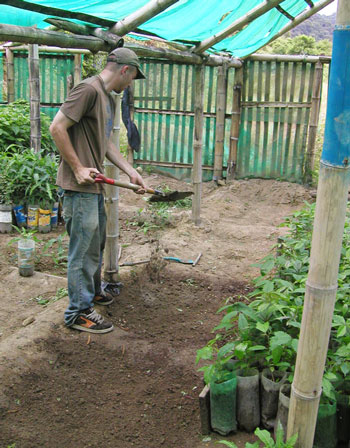April 16-25, 2008
It’s been a relatively quiet couple of weeks. The single volunteer Sara was replaced by Sam. Fortunately the workload hasn’t required more hands. As May approaches our numbers will be bolstered by some new arrivals.
On Wednesday the 16th of April the finishing touches on the Astillero site were completed. Each tree has a nicely shaped bowl around the base for watering and received a healthy dose of agua to help with the transplanting process. Some of the trees are on such a steep slope that they needed to have miniature terraces built around them in order to construct an adequate bowl shape.
There’s been a bit of a dry spell lately so we decided to visit some of the most vulnerable sites to give them a boost and some relief from the beating sun. On Thursday Sam and Jaime watered the Reales Tamarindos site and also paid the greenhouse a visit to water there as well.
On Friday they headed to the Don Pepe site for watering as well. Upon arrival there was the additional challenge of clearing weeds off of the trees.
Saturday morning a news article covering the revegetation project we’ve initiated in the Astillero neighborhood came out in the Bahia paper, El Nuevo Globo. It is available online here: http://www.elnuevoglobo.com/reforestacion.html [Note: this link does not seem to function any more]
Monday the Astillero site was watered again. The trees are doing well given that they were transplanted without rain water.On Tuesday Reales Tamarindos was watered. Afterwards, stakes to identify the location of trees were placed at the La Cruz site. Back at the office I began tackling revision of the Bioregionalismo booklet for Ramon’s class which will begin next Wednesday. The booklet needs be updated and edited before printing. We are also beginning to make worksheets for class topics such as: land ecosystems, flora, soil, marine ecosystems, the estuary, and birds. Class materials are being completely overhauled so they are more comprehensive and engaging.

Wednesday the La Cruz and Bosque en Medio de las Ruinas sites were watered. Some site maintenance was required at Ruinas, cutting back more weeds. I continued Bioregional Education material preparation. That afternoon I collected a load of compost from Ricardito’s pile since our reserves are running dangerously low and there’s going to be lots of planting and transplanting coming up in the near future.
On Thursday Jaime and Sam took off for the Nuevo Globo site to harvest more stakes from the fast growing Pelo Caballo trees which are prolific there. More Bioregional Ed class preparation work took place back in Bahia.
That evening I attended a pitiful environmental presentation in the Astillero neighborhood given by the Ecuadorian Army Corp of Engineers.After glossing over the international standards that they are following to construct the bridge they fielded questions by perturbed local residents who complained about the noxious amounts of dust generated from an incredibly deteriorated and heavily under construction main arterial road that leads through Bahia’s suburb. They refused to address questions about effects of the major increase in traffic that the bridge will bring to the region and questions about environmental implications for the estuary, side-stepping the issues by talking about all of the tourism and birdwatchers(!?) the bridge will bring and inviting people to visit their offices during the day. The presentation began with the confusing playing of the trailer for ‘An Inconvenient Truth’ and closed with another clip about global warming from the Discovery Channel. No further comment.
On Friday we had an incredibly productive day. A truck was rented to go up to the old compost processing facility where the city used to separate garbage. There are still enormous piles of collected organic materials which have now been untouched for well over a year. Needless to say they have now become massive amounts of compost. Why did they previously need big machines, which inevitably broke down, for mixing these piles? Forgive me for asking such questions. Decomposition is a naturally occurring phenomenon.

Sam and Jaime load up compost at the abandoned and overgrown organic waste processing facility of the Municipio.
And we took full advantage of it, loading the truck with the equivalent of at least 20 sacks worth of the very healthy, though mildly trash ridden compost. Sifting at the greenhouse will take care of the inorganic waste later.The compost was transported to the greenhouse. While there we met up with alumnus volunteer Lorna, who is revisiting Bahia. Enormous quantities of weeds were pulled.

Lorna pays one last visit to the greenhouse and helps us pull weeds.
Seed beds were prepared and Palo Santo, Guachepeli and Algarrobo seeds were planted. Sacks full of plastic waste left over from cutting trees out of bottles for this year’s planting were already waiting at the greenhouse. These were loaded into the emptied compost truck and taken to Leonidas Plaza to be dropped off at a recycling collector. Over 150 lbs. of three-liter plastic bottles were sent for further recycling!Hasta luego,
Clay

Sam sprinkles soil over a bed with Guachepeli seeds.

Can you be more specific about the content of your article? After reading it, I still have some doubts. Hope you can help me.
Can you be more specific about the content of your article? After reading it, I still have some doubts. Hope you can help me.